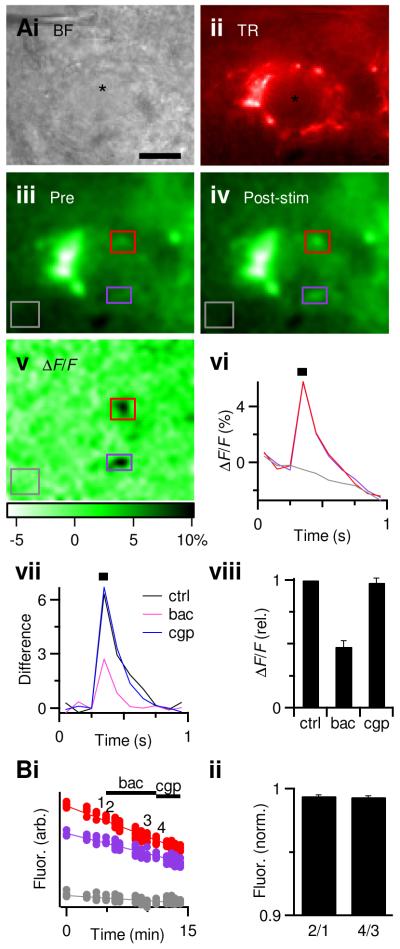Figure 4.
GABABR activation reduces presynaptic calcium influx.
A. Representative experiment showing BC (i) and endbulb, labeled by co-injection of dextran-conjugated Texas red (ii) and Oregon green (iii). Regions of interest are indicated by the purple and red boxes. The grey box represents an unlabeled region of interest to control for bleaching.
iv, Single frame showing fluorescence after endbulb stimulation (14 pulses at 200 Hz).
v, Changes in brightness, quantified as ΔF/F, using the average of three pre-stimulus frames for the baseline fluorescence.
vi, Changes in ΔF/F following stimulation (black bar). Trace colors match the regions of interest indicated by the boxes in iii–v. The ΔF/F in the unlabeled region (grey trace) was used to correct for bleaching in the labeled regions (colored traces) by subtracting.
vii, Average corrected responses. Traces are averages of 2, 3, and 2 trials for control, baclofen, and CGP55845 respectively.
viii. Average effects of GABABR activation on the corrected ΔF/F (n = 5). Baclofen significantly decreased the ΔF/F (P < 0.001, t-test), while CGP55845 was not significantly different from control conditions (P > 0.2).
B. Baseline fluorescence over the course of the experiment showing a steady decline as a result of bleaching (i), but no measurable changes resulting from drug application. ii, Average effects of GABABR activation on baseline fluorescence levels. To enhance detection of possible decreases in resting calcium, without contamination by bleaching, the fluorescence just before drug application was compared to just after drug application (the timing of measurements “1” through “4” are indicated on the example experiment in i. The change into baclofen (“2/1”) was not significantly different from the change into CGP55845 (“4/3”), indicating no detectable change in resting calcium.

